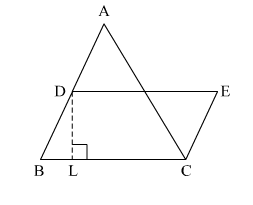In the given figure, a ∆ABC has been given in which AB = 7.5 cm, AC = 6.5 cm and BC = 7 cm. On base BC, a parallelogram DBCE of the same area as that of ∆ABC is constructed. Find the height DL of the parallelogram.

In ∆ABC,
The sides of the triangle are of length 7.5 cm, 6.5 cm and 7 cm.
∴ Semi-perimeter of the triangle is
$s=\frac{7.5+6.5+7}{2}=\frac{21}{2}=10.5 \mathrm{~cm}$
∴ By Heron's formula,
Area of $\Delta A B C=\sqrt{s(s-a)(s-b)(s-c)}$
$=\sqrt{10.5(10.5-7.5)(10.5-6.5)(10.5-7)}$
$=\sqrt{10.5(3)(4)(3.5)}$
$=21 \mathrm{~cm}^{2} \quad \ldots(2)$
Now,
Area of parallelogram DBCE = Area of ∆ABC
$=21 \mathrm{~cm}^{2}$
Also,
Area of parallelogram DBCE = base × height
$\Rightarrow 21=B C \times D L$
$\Rightarrow 21=7 \times D L$
$\Rightarrow D L=\frac{21}{7}=3 \mathrm{~cm}$
Hence, the height DL of the parallelogram is 3 cm.
Click here to get exam-ready with eSaral
For making your preparation journey smoother of JEE, NEET and Class 8 to 10, grab our app now.
